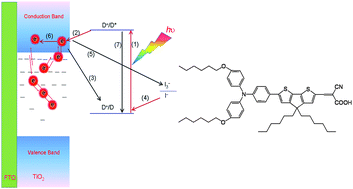Influence of the electrolyte cation in organic dye-sensitized solar cells: lithiumversusdimethylimidazolium†
Abstract
We investigate the influence of electrolyte cations such as

* Corresponding authors
a
State Key Laboratory of Polymer Physics and Chemistry, Changchun Institute of Applied Chemistry, Chinese Academy of Sciences, Changchun 130022, China
E-mail:
peng.wang@ciac.jl.cn
Fax: +86 431 852 629 53
Tel: +86 431 852 629 52
b Graduate School, Chinese Academy of Sciences, Beijing 100039, China
We investigate the influence of electrolyte cations such as

 Please wait while we load your content...
Something went wrong. Try again?
Please wait while we load your content...
Something went wrong. Try again?
R. Li, D. Liu, D. Zhou, Y. Shi, Y. Wang and P. Wang, Energy Environ. Sci., 2010, 3, 1765 DOI: 10.1039/C0EE00223B
To request permission to reproduce material from this article, please go to the Copyright Clearance Center request page.
If you are an author contributing to an RSC publication, you do not need to request permission provided correct acknowledgement is given.
If you are the author of this article, you do not need to request permission to reproduce figures and diagrams provided correct acknowledgement is given. If you want to reproduce the whole article in a third-party publication (excluding your thesis/dissertation for which permission is not required) please go to the Copyright Clearance Center request page.
Read more about how to correctly acknowledge RSC content.
 Fetching data from CrossRef.
Fetching data from CrossRef.
This may take some time to load.
Loading related content
